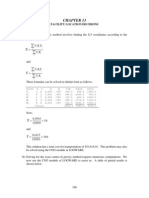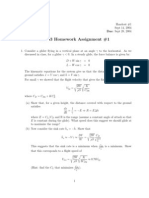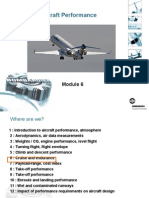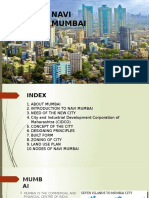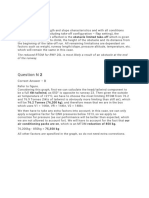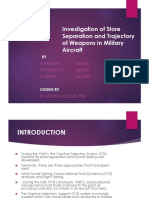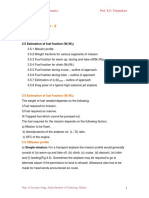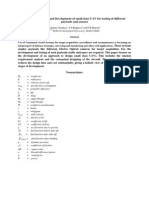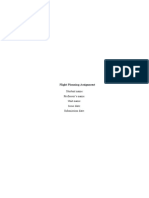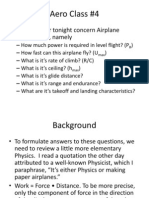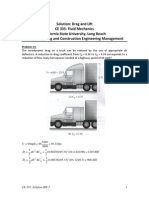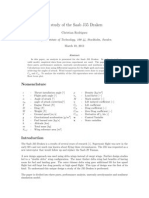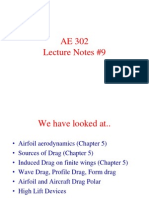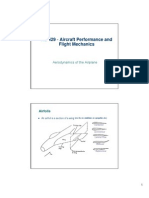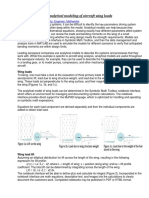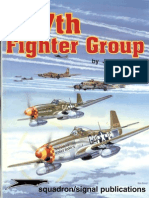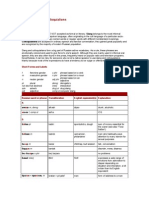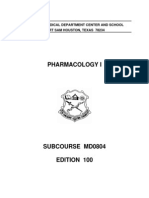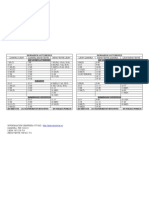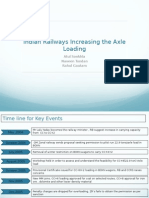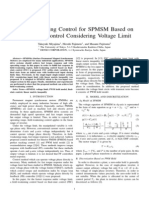Aircraft Flight Strategies: David Arterburn, Michael Jaye, Joseph Myers, Kip Nygren
Aircraft Flight Strategies: David Arterburn, Michael Jaye, Joseph Myers, Kip Nygren
Uploaded by
Killer_RCopyright:
Available Formats
Aircraft Flight Strategies: David Arterburn, Michael Jaye, Joseph Myers, Kip Nygren
Aircraft Flight Strategies: David Arterburn, Michael Jaye, Joseph Myers, Kip Nygren
Uploaded by
Killer_ROriginal Title
Copyright
Available Formats
Share this document
Did you find this document useful?
Is this content inappropriate?
Copyright:
Available Formats
Aircraft Flight Strategies: David Arterburn, Michael Jaye, Joseph Myers, Kip Nygren
Aircraft Flight Strategies: David Arterburn, Michael Jaye, Joseph Myers, Kip Nygren
Uploaded by
Killer_RCopyright:
Available Formats
31
Aircraft Flight Strategies
David Arterburn
1
, Michael Jaye, Joseph Myers, Kip Nygren
1
Introduction
Three important considerations in every flight
operation are the altitude (possibly variable)
at which to travel, the velocity (possibly
variable) at which to travel, and the amount of
lift that we choose to generate (at the expense
of fuel consumption again possibly variable)
during the flight. It turns out that when
planning a flight operation, one cannot just
choose any desired value for each of these
three quantities; they are dependent upon one another. We can relate these
three quantities through a set of equations known as the Breguet (pronounced
bre-ga) Range Equations. These equations are derived in Appendix A.
Deriving these equations shows that once we decide to choose constant values
for any two of altitude, lift coefficient, and velocity, the third is automatically
determined. Thus there are three basic independent flight strategies: constant
altitude/constant lift coefficient, constant velocity/constant altitude, and constant
velocity/constant lift coefficient. Exercise 1 asks you to analyze how the third
quantity must vary under each of these flight strategies.
Commercial flight operations are generally conducted at constant
velocity/constant lift coefficient in order to save fuel. In military operations,
however, there are often other considerations that override cost efficiency, and
thus dictate the choice of a different flight strategy. Surveillance/reconnaissance
flights generally dictate flying at constant velocity/constant altitude in order to
best gather required intelligence. Phased air operations are sometimes better
coordinated when restricted to constant velocity. When several sorties are in
the air at the same time, especially both outbound and inbound, safe airspace
management often dictates flights at constant specified altitudes. Exercise 2
asks you to more closely analyze which flight strategy may be most appropriate
for which military mission. Thus unlike most commercial operations, the military
planner must be prepared to operate under any of several different flight
strategies.
The following scenarios demonstrate how different techniques of single variable
calculus can assist in analyzing the governing equations to yield important
information about flight operations. Concepts covered include modeling with
1
Department of Civil and Mechanical Engineering, USMA
32
derivatives, numerical integration, analytic integration, and graphical analysis (of
range strategies).
Scenario: A-10 Close Air Support
You are the pilot on an A-10 Thunderbolt, Close Air Support (CAS) aircraft.
Among the many things for which you are responsible, some of the particular
aspects are to determine within what radius your plane can safely service CAS
targets, how long it can "loiter" in a target area, and when it must return for
refueling.
Now, an interesting aspect of your job is that, at times, some of the instruments
malfunction. This forces you to double-check your instruments' accuracy
through other means, or to rely on these other means to plan your plane's flight.
In this project you are going to answer several questions about the flight of your
craft based primarily on your plane's fuel consumption. (Your fuel gauge is
known to be working).
Figure 1: The A-10B Thunderbolt
Strategy 1: Flying at Constant Velocity/Constant Lift Coefficient
Range Equation:
You can answer questions regarding how far the plane can travel by relating the
distance traveled by the plane to the weight of fuel that it consumes. Assume
that you fly at constant velocity and with a constant coefficient of lift (thus, you
increase altitude over time as your plane gets progressively lighter). From our
knowledge of fluid dynamics, we have the following relationship (this and all
following relationships are derived in Appendix A):
33
W C
C
c
V
dW
dx
D
L
1
= ,
where x = distance traveled, W = weight, V = velocity, c is the coefficient of fuel
consumption (c = 0.3700 lbs. of fuel/hr/lb thrust), and the ratio
C
L
C
D
is 3.839 for
constant lift coefficient. Thus, the distance traveled, x, is given by:
dW
finish
W
start
W
W
D
C
L
C
c
V
x
=
1
.
Example 1: You take off weighing 40,434 lbs (this weight includes fuel,
armament, and ordnance) and you travel at V = 347.5 mi/hr. You arrive at the
target area weighing 36,434 lbs. By use of a numerical integration technique,
with an increment size of 1000 lbs in your partition, estimate the distance you
have traveled. Does your answer depend on your increment size?
Solution: This requires us to numerically evaluate the integral
434 , 36
434 , 40
8 . 3605
W
dW
,
which we rewrite as
434 , 40
434 , 35
8 . 3605
W
dW
. We use the trapezoidal rule
) * * 5 . * * * 5 (. * 8 . 3605
1
1
0
W f W f W f x
n
n
i
i
+ + =
=
to evaluate the integral, with
W
W f
1
) ( = and 1000 = W . Substituting for f
yields: ) * 434 , 40 * 5 . *
1
* 434 , 35 * 5 (. * 8 . 3605
1
1
W W
W
W x
n
i
i
+ + =
=
, where
i
W
is the value of W in the th i' subinterval (equal to
) 434 , 35 434 , 40 ( * ) 1 ( 434 , 35 + = i W
i
). This technique is implemented in the
following spreadsheet:
Initial W: 36434
Final W: 40434
Intervals: 4
Delta W: 1000 Distance: 375.6537
W f(W) Partial Sum
36434 2.74469E-05 0.013723
37434 2.67137E-05 0.040437
38434 2.60186E-05 0.066456
39434 2.53588E-05 0.091815
40434 2.47317E-05 0.10418
34
This yields a distance traveled of 375.6 miles. We look to the next example to
better answer the question is the calculated range a function of increment
size?
Example 2: Refine your estimate by increasing the number of partitions. What
appears to be the limit as the number of partitions increases without bound?
Solution: Repeating the above process for differing numbers of subintervals
yields the following sequence of values for the distance traveled:
The calculated range appears to be a monotonically decreasing function of the
number of subintervals (or conversely, a monotonically increasing function of
increment size). This also appears to be a convergent sequence with a limit of
approximately 375.6 miles. Note how few terms are required (in this case) to
converge very close to the apparent limit of the numerical integration scheme.
Example 3: Now evaluate the definite integral to find the distance traveled.
Solution: Evaluating the definite integral, which is easy to do for this simple
integrand, yields 6112 . 375 | ) ln( * 8 . 3605 8 . 3605
434 , 40
434 , 36
434 , 40
434 , 35
= =
W
W
dW
miles. This is in
excellent agreement with the numerical solution above.
Endurance Equation
To determine how long you can loiter in the target area with a given amount of
fuel, we need to relate the time t to the fuel consumption. With the help of some
equations from our fluid dynamics background, we find that, if we assume that
we are loitering at a constant velocity, V, and a constant lift coefficient
L
C , we
have
Intervals Distance
4 375.6537
10 375.618
20 375.6129
40 375.6116
100 375.6112
400 375.6112 375.58
375.6
375.62
375.64
375.66
4 10 20 40 100 400
Number of Intervals (not to scale)
D
i
s
t
a
n
c
e
T
r
a
v
e
l
e
d
35
dt
dW
dx
dW
dx
dt
c
C
L
C
D
W
= =
1 1
Thus, t, the loiter time, is given by:
dW
end
W
begin
W W
D
C
L
C
c
dW
end
W
begin
W W
D
C
L
C
c
t = =
1 1 1 1
Example 4:
You arrived at the target weighing 36,434 lbs. The S-3 (Air) directs you to
reconnoiter the target for 15 minutes (0.2500 hour). How much fuel will you
have for your return trip assuming that the plane weighs 29,784 lbs with its
armament and ordnance but no fuel?
Solution: Substituting into the endurance equation yields
=
final
W
W
dW
434 , 36
3757 . 10 2500 . 0 , which we rewrite as
=
434 , 36
3757 . 10 2500 . 0
final
W
W
dW
.
Evaluating yields ) ln( ) 434 , 36 (ln( 3757 . 10 2500 . 0
final
W = . Solving for
final
W yields
6 . 566 , 35 =
final
W lb. This means that we will have 35,566.6 - 29,784 = 5782.6 lbs
of fuel remaining when we are ready to return.
Strategy 2: Flying at Constant Velocity/Constant Altitude
For tactical reasons, you are required to return home at constant velocity and
constant altitude. You must, therefore, decrease your lift as your plane lightens
by decreasing your lift coefficient. It turns out, after some work, that we can
derive the relationship
( )
2
1
1
aW
o
D
SC q c
V
dW
dx
+
= ,
where ,
11
10 330 . 2
= a 03700 . 0 =
o
D
C , q = 541.894, S = 506.0 ft
2
(the surface
area of the wing), and c = 0.3700 lbs of fuel/hr/lb thrust.
Thus, the distance
traveled, in miles, is given by:
( )
dW
arrive
W
depart
W aW
o
D
SC q c
V
dW
arrive
W
depart
W
aW
o
D
SC q c
V
x
+
=
+
=
2
1
1
2
1
1
36
Example 5:
You have expended all your ordnance, your mission is complete, and you find
yourself 478.0 miles away from the airfield. You will return to the field at a
constant velocity, V = 460.4 mi/hr, and at a constant altitude. Can you make it
home on 4500 lbs of fuel? If so, then how much fuel do you have remaining
when you do arrive? If not, then how much additional fuel would you need?
Your craft weighs 24,959 lbs when empty of both fuel and ordnance.
Solution: Substituting into the constant velocity/constant altitude equation
yields
+
=
959 , 24
459 , 29
2 11
) 10 330 . 2 1 (
12265 .
W
dW
x . Note that we have the freedom here
to choose any integration technique (numerical, analytic, Computer Algebra
System (CAS)) that we desire. A little experimentation shows that this integral is
not going to yield to any of the analytic integration techniques that we (at least
most of us) have studied so far. We turn next to our favorite Computer Algebra
System (MathCad, Derive, etc), and find symbolically that
959 , 24
459 , 29
11 1 2 / 1 11
| ) 10 330 . 2 ( tan ) 10 330 . 2 ( 12265 . W x
= , or evaluating numerically
that 546 . 542 = x miles. Therefore we will make it home with 542.5 - 478.0 = 64.5
miles to spare.
Strategy 3: Flying at Constant Altitude/Constant Lift Coefficient
We have discussed two flight strategies, namely flight at constant
velocity/constant lift coefficient, and flight at constant velocity/constant altitude.
A third strategy is constant altitude/constant lift coefficient. Now, constant lift
coefficient will require you to slow down over time as your plane lightens
(otherwise your plane will climb). It turns out for this strategy that we can derive
the relationship
dW
2 / 1
W
1
D
C
L
C
S
2
c
1
dW
dx
= .
So the distance that you can travel, in miles, is given by
dW
end
W
start
W
2
1
W
1
D
C
L
C
S
2
c
1
dW
end
W
start
W
2
1
W
1
D
C
L
C
S
2
c
1
x
=
=
.
where 002377 . 0 = slug/ft
3
(air density) and
C
L
C
D
= 9.997.
Exercise 4 asks you to compare this strategy to the two already presented.
(Hint: You may find that a graphical approach yields the most satisfactory
comparison when trying to answer Does it ever happen that type questions.)
37
Exercises
1. Use the Breguet range equations in Appendix A to determine the following.
In each case, explain why your answer is intuitively plausible.
a. For a constant altitude/constant lift coefficient flight operation, how must
the velocity of the aircraft vary during the flight?
b. For a constant velocity/constant altitude flight operation, how must the lift
coefficient of the aircraft vary during the flight?
c. For a constant velocity/constant lift coefficient flight operation, how must
the altitude of the aircraft vary during the flight?
2. For each mission, decide which flight strategy may be best. Explain your
reasoning.
a. Mission: A surveillance/reconnaissance flight conducted at night,
designed to gather intelligence about a point target.
b. Mission: A routine transportation flight, charged with delivering troops
and equipment to a designated training area.
c. Mission: A high priority intercept mission to head off unidentified
incoming aircraft and maintain maximum standoff from an aircraft
battle group in a hostile theater.
d. Mission: Routine flight operations in the vicinity of a very busy CONUS
airfield.
3. If we have only a limited amount of fuel on board, which of the three flight
strategies allows you to travel the furthest? Is any one of the three always best?
Is any one of the three always the worst?
4. The Voyager was the first aircraft successfully flown non-stop around the
world. How do you think the Breguet equations (along with other design
considerations) played a role in the design of this unique aircraft for this very
specialized mission?
5. Repeat Requirements 1 through 3 for the F-15E Eagle, using the aircraft data
found in Appendix B.
References
[1] Anderson, John D., Introduction to Flight, 3d Ed., New York, McGraw-Hill,
1989.
[2] Millikan, Clark, B., Aerodynamics of the Airplane, New York, Wiley, 1941.
[3] Perkins, Courtland D., and Robert E. Zhage, Airplane Performance, Stability,
and Control, New York, Wiley, 1949.
38
APPENDIX A: DERIVATION OF THE BREGUET RANGE AND ENDURANCE
EQUATIONS
1. Mathematical Model:
Lift (L) = Weight of the aircraft (W) (by Newtons second law, assuming no or
negligible vertical acceleration)
Thrust (T) = Drag on the aircraft (D) (by Newtons second law, assuming no
or negligible horizontal acceleration)
Velocity (V) = dx/dt (where x is the position of the plane at time t)
-dW/dt = cT (loss of weight, all due to fuel consumption, is directly
proportional to the thrust produced; c is the specific fuel
consumption in units of lbs fuel/(hr x lbs thrust))
2. Definitions:
Coefficient of lift:
S q
L
C
L
=
Coefficient of drag:
S q
D
C
D
=
2
0
L D D
KC C C + = , where
2
2
1
V q = , = air density, S =wing area,
and
0
D
C and K are constants.
3. Derived Relationships:
D
L
C
C
D
L
=
L
D
C
C
W
L
D
W D T = = =
L
SC
W
V
2
=
4. Range Equation for Constant Altitude ( constant) and constant
L
C :
cT
V
dx
dW
dt
dW
= = , or
V
cT
dx
dW
= and
cT
V
dW
dx
= .
By substituting for V :
2 1
2 1
1 2 1 2 1
W C
C
SC W C
C
SC
W
c dW
dx
D
L
L D
L
L
= =
39
5. Range Equation for Constant Velocity and Constant
L
C :
W C
C
c
V
dW
dx
D
L
1
=
6. Range Equation for Constant Velocity and Constant Altitude:
cD
V
cT
V
dW
dx
= =
Substituting for Drag, where ) (
2
0
L D D
KC C S q SC q D + = = and
S q
W
C
L
= yields:
) 1 (
1
) (
2 2
0
0
aW SC q c
V
S q
KW
SC q c
V
dW
dx
D
D
+
=
+
= , where
0
2 2
D
C S q
K
a = .
7. Endurance Equation for a Jet Aircraft at Constant
L
C :
W C
C
c cT dW
dt
D
L
1 1 1
= = .
40
APPENDIX B: AIRCRAFT DATA FOR THE F-15E EAGLE
Fuel consumption (lb/hr/lb) 0.9
D L
C C 6.193
Take Off Weight (lb) 62,323
Arrival Weight (lb) 58,323
Flight Velocity (mi/hr) 347.5
Aircraft Weight (no fuel, 49,200
with ordnance)
a (1/lb
2
) 5.866E-11
0
D
C 0.026
q (lb
2
/ft
2
) 518.503
S (ft
2
) 608
Aircraft Empty Weight (lb) 31,700
Flight Velocity (mi/hr) 347.5
Distance (mi) 325
D L
C C 13.928
You might also like
- Pre ATPL Maths and Physics Revision Course-1Document23 pagesPre ATPL Maths and Physics Revision Course-1filzovoc91% (11)
- Ballou Logistics Solved Problems Chapter 13Document42 pagesBallou Logistics Solved Problems Chapter 13RenTahL60% (5)
- API 650 - Cone Roof Tank AnalysisDocument44 pagesAPI 650 - Cone Roof Tank AnalysisKautilya SharmaNo ratings yet
- Routing Problems 6.1. Vehicle Routing Problems Vehicle Routing Problem, VRPDocument6 pagesRouting Problems 6.1. Vehicle Routing Problems Vehicle Routing Problem, VRPDrPeter de BarcelonaNo ratings yet
- Rumanian Air Force - The Prime Decade - 1938-1947Document81 pagesRumanian Air Force - The Prime Decade - 1938-1947Killer_R100% (5)
- Tutorial 3Document8 pagesTutorial 3bicky bongNo ratings yet
- AnsDocument4 pagesAnsDinesh YadavNo ratings yet
- MIT Aircraft Stability and Control 02 - AssignmentsDocument14 pagesMIT Aircraft Stability and Control 02 - AssignmentsAndré Da Luz MoreiraNo ratings yet
- Module 6Document31 pagesModule 6PSkotsNo ratings yet
- Engineering ReportDocument14 pagesEngineering ReportMirudulaPuguajendiNo ratings yet
- Aim-120 Amraam TrainDocument89 pagesAim-120 Amraam TrainKiller_R100% (2)
- Boiler Preservation Methods Dry and WetDocument14 pagesBoiler Preservation Methods Dry and WetTin Aung KyiNo ratings yet
- Navi Mumbai: Town PlanningDocument41 pagesNavi Mumbai: Town Planningriya bhardwaj67% (3)
- Official Monogram US Navy & Marine Corps Aircraft Color Guide Vol 1 1911-1939 PDFDocument195 pagesOfficial Monogram US Navy & Marine Corps Aircraft Color Guide Vol 1 1911-1939 PDFjdetrick6613100% (12)
- Weight and Balance: Loading DefinitionsDocument6 pagesWeight and Balance: Loading DefinitionsJuly TadeNo ratings yet
- Ex.3 210101031,210101032Document9 pagesEx.3 210101031,210101032S BNo ratings yet
- 1500 Passenger AircraftDocument14 pages1500 Passenger AircraftrjramanathanNo ratings yet
- Aeronautics: Aeronautical Calculations: What's With All Those Coefficients Anyway?Document2 pagesAeronautics: Aeronautical Calculations: What's With All Those Coefficients Anyway?Baldev RamNo ratings yet
- Flight Mechanics Numericals With SolutionDocument27 pagesFlight Mechanics Numericals With Solutionmanikandan_murugaiahNo ratings yet
- 032 - Performance - AnswersDocument139 pages032 - Performance - AnswersEASA ATPL Question BankNo ratings yet
- Range EnduranceDocument20 pagesRange EnduranceHelloWorldNo ratings yet
- Investigation of Store Separation and Trajectory of WeaponsDocument16 pagesInvestigation of Store Separation and Trajectory of WeaponsPraveenNo ratings yet
- Aircraft Weight EstimationDocument24 pagesAircraft Weight Estimationgiganticvis50% (2)
- Weight Estimation - 2 Topics: 3.5 Estimation of Fuel Fraction (W /W)Document13 pagesWeight Estimation - 2 Topics: 3.5 Estimation of Fuel Fraction (W /W)kdastro009No ratings yet
- AE462 Term Project 2022Document22 pagesAE462 Term Project 2022Emine YASANNo ratings yet
- Rigging and Lifting Handbook SampleDocument26 pagesRigging and Lifting Handbook Samplemohan100% (1)
- RRDPAE 2008 Presentation ATR72Document28 pagesRRDPAE 2008 Presentation ATR72Eduardo SawasakiNo ratings yet
- Preliminary Design and Development of Small Class UAV For Testing of Different Payloads and SensorsDocument6 pagesPreliminary Design and Development of Small Class UAV For Testing of Different Payloads and SensorsAlg PRasadNo ratings yet
- Math For Pilots: Airplane Performance Density AltitudeDocument7 pagesMath For Pilots: Airplane Performance Density AltitudeLucas NobreNo ratings yet
- Kaung Si Thu (VI Mech-50) BE Thesis 2Document29 pagesKaung Si Thu (VI Mech-50) BE Thesis 2tincung25No ratings yet
- Cruise Flight - Range and Endurance of Propeller Driven AircraftDocument5 pagesCruise Flight - Range and Endurance of Propeller Driven Aircraftagautam07No ratings yet
- Homework Set 4 (1)Document2 pagesHomework Set 4 (1)chiang142536No ratings yet
- Mental MathsDocument13 pagesMental MathsMarcelo PetilloNo ratings yet
- AEE462 - Project - Part 1 - Spring 2022Document4 pagesAEE462 - Project - Part 1 - Spring 2022öznur uluNo ratings yet
- Report 1: Performance Analysis of A Finite Aspect Ratio WingDocument12 pagesReport 1: Performance Analysis of A Finite Aspect Ratio WingRODRIGO MARTIN ORTIZNo ratings yet
- (MECH1907) (2021) (F) Final Kbuox7e 32726Document10 pages(MECH1907) (2021) (F) Final Kbuox7e 32726Wish SetsNo ratings yet
- Tut4 PromptDocument4 pagesTut4 PromptAryan PandeyNo ratings yet
- Flight Planning AssignmentDocument14 pagesFlight Planning AssignmentJamesNo ratings yet
- Aero Class #4: - The Topics For Tonight Concern Airplane Performance, NamelyDocument29 pagesAero Class #4: - The Topics For Tonight Concern Airplane Performance, NamelySLNo ratings yet
- Solution Practice Drag and LiftDocument3 pagesSolution Practice Drag and Liftmrm3za100% (1)
- Project ReportDocument15 pagesProject ReportFaIz FauziNo ratings yet
- Longitudinal Stability and Trim.: 4.1. Aircraft Statics-Force BalanceDocument8 pagesLongitudinal Stability and Trim.: 4.1. Aircraft Statics-Force BalanceendoparasiteNo ratings yet
- D3 Report V2 CopyDocument7 pagesD3 Report V2 CopyAlan ClarkNo ratings yet
- Aerospace Design Assignment IDocument11 pagesAerospace Design Assignment IMerve SümerNo ratings yet
- Static Stability: V S L S C V S C S LDocument6 pagesStatic Stability: V S L S C V S C S LLogadhasan SuwedanNo ratings yet
- Christian Rodriguez Final PaperDocument13 pagesChristian Rodriguez Final PaperChristian RodriguezNo ratings yet
- AE 302 Lecture Notes #9Document17 pagesAE 302 Lecture Notes #9sgatusNo ratings yet
- Report 2Document16 pagesReport 2Krishna DuttNo ratings yet
- Ae 429 3Document20 pagesAe 429 3Ridzuan 'vladimir'No ratings yet
- A350 Case StudyDocument32 pagesA350 Case StudyTeddy AndriantsihoaranaNo ratings yet
- 6 R Session: Multivariate Extremes and Bayesian InferenceDocument7 pages6 R Session: Multivariate Extremes and Bayesian InferencePhamNtNo ratings yet
- Weight and Balance: Center of Gravity ComputationDocument5 pagesWeight and Balance: Center of Gravity ComputationJuly TadeNo ratings yet
- AE451 Study3 RaporDocument12 pagesAE451 Study3 RaporAlptuğ GürNo ratings yet
- Mass & Balance Q&ADocument109 pagesMass & Balance Q&AAdwikaNo ratings yet
- Differential Equations Coursework Aeroplane LandingDocument6 pagesDifferential Equations Coursework Aeroplane Landingujsqjljbf100% (3)
- M (A O.g074) - Assuming That The Coefficient of Friction Between The Tires and TheDocument1 pageM (A O.g074) - Assuming That The Coefficient of Friction Between The Tires and ThevibhubhatNo ratings yet
- Steady Level FlightDocument13 pagesSteady Level Flighthuy.nguyen2992003No ratings yet
- Classical Aircraft Sizing I: W. H. MasonDocument19 pagesClassical Aircraft Sizing I: W. H. MasonMir PeerNo ratings yet
- Lecture Note 2Document56 pagesLecture Note 2Tolga Burak UysalNo ratings yet
- Test Module BansDocument5 pagesTest Module BansCristian CasasNo ratings yet
- 8Document7 pages8Crystal MurrayNo ratings yet
- Analytical Modeling of Aircraft Wing LoadsDocument5 pagesAnalytical Modeling of Aircraft Wing LoadsrichardchwaNo ratings yet
- Cart Calibration (Measuring The Spring Constant) : Laboratory Experiment No. 3Document3 pagesCart Calibration (Measuring The Spring Constant) : Laboratory Experiment No. 3Marites SibalNo ratings yet
- A-level Physics Revision: Cheeky Revision ShortcutsFrom EverandA-level Physics Revision: Cheeky Revision ShortcutsRating: 3 out of 5 stars3/5 (10)
- Projects With Microcontrollers And PICCFrom EverandProjects With Microcontrollers And PICCRating: 5 out of 5 stars5/5 (1)
- Squadron Signal - 6077 - Aces Part 1Document66 pagesSquadron Signal - 6077 - Aces Part 1Vesna87100% (8)
- 357th Fighter Group in WWIIDocument66 pages357th Fighter Group in WWIIKiller_R100% (4)
- Ruso - Colloquial Russian Phrase BookDocument9 pagesRuso - Colloquial Russian Phrase BookKiller_RNo ratings yet
- US Army Medical Pharmacology IDocument202 pagesUS Army Medical Pharmacology ISpace_Hulker100% (3)
- LeonzamoraDocument1 pageLeonzamoraKiller_RNo ratings yet
- UnamidDocument1 pageUnamidKiller_RNo ratings yet
- FX1S HardwareManual JY992D83901-PDocument94 pagesFX1S HardwareManual JY992D83901-PJms QuinteroNo ratings yet
- Berryman 1999Document3 pagesBerryman 1999Falza WihdanyNo ratings yet
- 1035 Pasta ZinquenolicaIDocument2 pages1035 Pasta ZinquenolicaISagitario SolitarioNo ratings yet
- Amr CV - 2024Document4 pagesAmr CV - 2024hefnawyhbrcNo ratings yet
- Risk Analytics MasterDocument212 pagesRisk Analytics MastersstammsNo ratings yet
- SyllabusDocument3 pagesSyllabuskavskarNo ratings yet
- MasKargo CsDocument1 pageMasKargo CsLuqma IllieanaNo ratings yet
- 2022-03-08-FRECA-Technical Regulation PDFDocument81 pages2022-03-08-FRECA-Technical Regulation PDFDiederik KindsNo ratings yet
- Synchronization Checklist PDFDocument8 pagesSynchronization Checklist PDFAdhyartha Keraf100% (1)
- Nasik ListDocument144 pagesNasik ListArpit Kulshreshtha50% (2)
- Big 5 Egypt Sales Brochure 2019 OnlineDocument12 pagesBig 5 Egypt Sales Brochure 2019 OnlineDr. S.No ratings yet
- EX1406Document2 pagesEX1406igualdi53No ratings yet
- Special Packaging Instruction: (Cage) NomenclatureDocument2 pagesSpecial Packaging Instruction: (Cage) NomenclatureMatt ShultzNo ratings yet
- Schedule-of-rates-MI 2014-15Document151 pagesSchedule-of-rates-MI 2014-15Vinisha RaoNo ratings yet
- Administracion de Usuarios OracleDocument13 pagesAdministracion de Usuarios OracleCorrea Jimenez AlejandroNo ratings yet
- Final Report Colombo Dockyard PLCDocument69 pagesFinal Report Colombo Dockyard PLCDhanuka0% (1)
- Iec 61537 2023Document152 pagesIec 61537 2023imad qaissouniNo ratings yet
- Indian Railways Increasing The Axle Loading: Atul Sonkhla Naveen Tondan Rahul GautamDocument8 pagesIndian Railways Increasing The Axle Loading: Atul Sonkhla Naveen Tondan Rahul Gautam01202No ratings yet
- Force On Conductor LabDocument3 pagesForce On Conductor LabRezanoor KabirNo ratings yet
- CHAPTER 8-FluidDocument26 pagesCHAPTER 8-FluidRN Builder IpohNo ratings yet
- Generator KVA KW Amp ChartDocument2 pagesGenerator KVA KW Amp Chartthanatos6627No ratings yet
- Pile Driving Analyzed and Solution-Khmer D&C Review-Kdc27082024Document55 pagesPile Driving Analyzed and Solution-Khmer D&C Review-Kdc27082024Dieu17586No ratings yet
- Field-Weakening Control For SPMSMDocument6 pagesField-Weakening Control For SPMSMmgecicNo ratings yet
- HomeworkDocument4 pagesHomeworknicoleNo ratings yet
- Singapore Geology Its Impact On Underground Construction Works 16 Oct 2016 SMCESDocument90 pagesSingapore Geology Its Impact On Underground Construction Works 16 Oct 2016 SMCESNathan VincentNo ratings yet
- Norcure RealkalisationDocument2 pagesNorcure Realkalisationm.elsanee.cubicNo ratings yet

